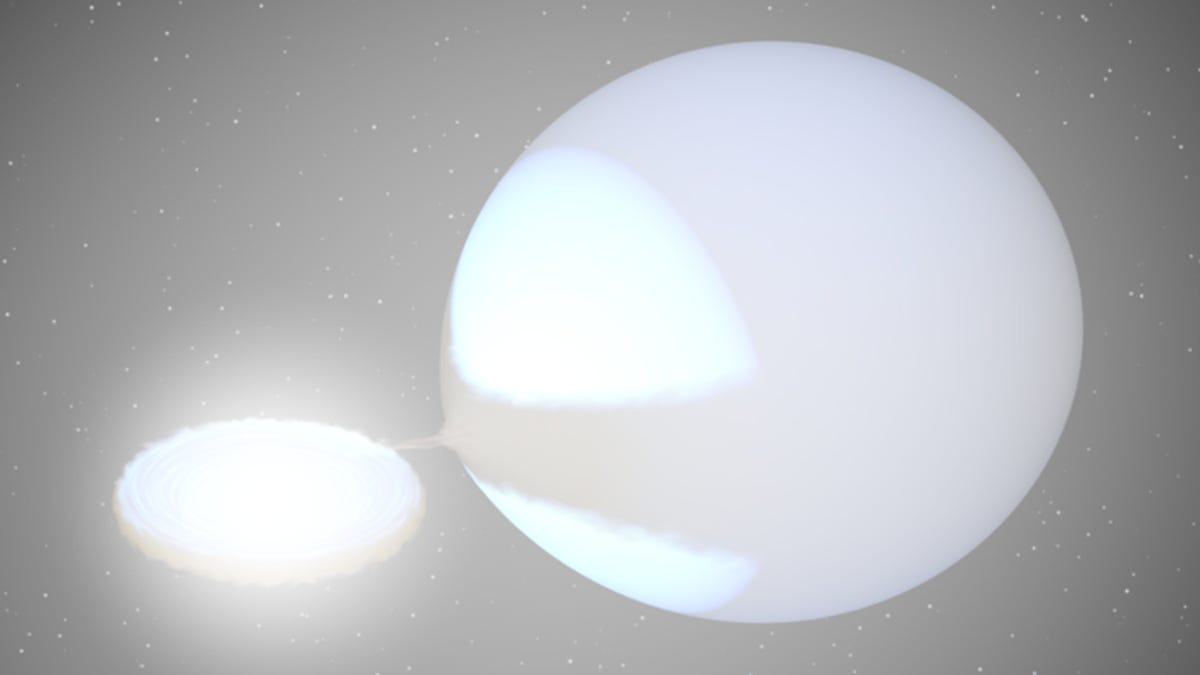Star caught in a death spiral will brighten and explode long before Betelgeuse
You've probably never seen or heard of the star V Sagittae, but stick around long enough and it will become impossible to miss.

V Sge is actually two stars spiraling around each other toward an inevitable, explosive merger.
The supergiant star Betelgeuse has been acting weird lately, suggesting it might soon go supernova, but astronomers from Louisiana State University say a much smaller star has a far better chance of exploding in the not-too-distant future.
"We now have a strong prediction for the future of V Sge," said LSU astronomy Professor Emeritus Bradley E. Schaefer at a meeting of the American Astronomical Society in Honolulu Monday.
Schaefer and his colleagues say V Sge (short for V Sagittae), which is actually a binary pair of a small white dwarf and a larger star more like our sun, will rapidly brighten over the next few decades until finally merging explosively around the year 2083.
That's practically a second away in cosmic time. Consider that the time range for the imminent end of Betelgeuse is sometime between now and 100,000 years from now.
"In the final days of this death spiral, all of the mass from the companion star will fall onto the white dwarf, creating a super-massive wind from the merging star, appearing as bright as Sirius, possibly even as bright as Venus," he explained in a release.
The system is over 7,000 light-years away, so no need to worry about its big boom directly affecting us on Earth.
V Sge is currently a faint star at the top of the constellation Sagitta (Latin for "arrow"), but that will change later this century.
V Sge is what's known to astronomers as a cataclysmic variable (CV): basically a binary star system with some sort of weird or extreme behavior. This particular binary is about as extreme as it gets, with a brilliant luminosity and impressive stellar wind coming off of it due to the fact that the sun-like star is almost four times as massive as the white dwarf it orbits.
"In all other known CVs the white dwarf is more massive than the orbiting normal star, so V Sge is utterly unique," said Schaefer.
When the scientists took a close look at the interaction between the two stars, including from old sky photos dating all the way back to 1890, they found the system has been getting brighter for over a century as the gap between the spiraling pair has rapidly shrunk. Analyzing past observations of V Sge over the decades also gave the team a glimpse of its violent future.
When it blows, V Sge will temporarily become a "new star" as bright as Venus or other bright stars like Sirius.
"The fate of V Sge is sealed," added Schaefer. He explains that, sometime between 2067 and 2099, the system will reach peak brightness just short of a supernova and lasting for about a month as the two stars merge into one.
"V Sge will appear startlingly bright in the night sky... the last time any 'guest star' appeared brighter was Kepler's Supernova in the year 1604."
In other words, if we can all hang on for another 50 to 80 years, we might not see just the show of the century, but one for the millennium.
Originally published Jan. 6.

